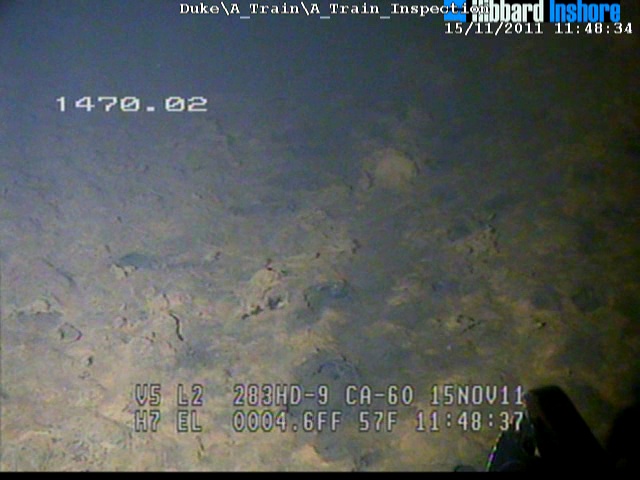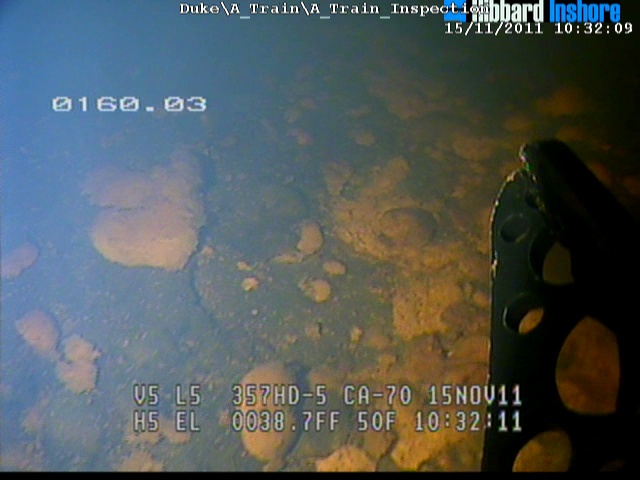Nuclear Power Plant Cooling Water Intake Inspection
 This photo shows the condition of the invert at 1470 feet. There were no significant debris or anomalies located in the search area past the 90 degree elbow.
This photo shows the condition of the invert at 1470 feet. There were no significant debris or anomalies located in the search area past the 90 degree elbow.
A nuclear power plant identified a potential issue with a partial blockage in one of its cooling water intakes as it was not able to draw the volume of water that was expected. After trying several methods to locate the potential blockage without placing anything into the line, the customer determined that the best method for ultimately identifying a blockage and characterizing it for remediation would be to perform an internal inspection of the line with an ROV. At this point, they approached Hibbard Inshore. It was imperative that nothing interfere with the operation of this pipeline as it was a first line of defense in case of an overheating issue. Due to the critical nature of this cooling water pipeline, dewatering was not an option. Additionally, the length and many bends in the pipeline represented a definite safety risk in using a dive team. Hibbard Inshore was able to provide a small vehicle that could fit into the pipeline, carry both video and sonar, navigate the distance of the line, and perhaps most importantly could navigate the many bends with very low friction thereby reducing the risk of retrieving the vehicle.
To mitigate the safety risk and ensure that the Remotely Operated Vehicle (ROV) would navigate the bends in the pipe without risk of being stuck, Hibbard Inshore worked with the client to fabricate a pipeline of the same size with precisely the same bends the ROV would encounter in the actual pipeline. Usually, a demonstration of this sort is not necessary but due to the critical nature of the nuclear plant, it was requested and Hibbard Inshore had a direct analog to the existing pipe fabricated as a test stand for the vehicle. Once the test pipe was fabricated, Hibbard Inshore and the customer presided over testing where the force to haulback the vehicle was measured at strategic locations throughout the pipe. Hibbard Inshore demonstrated the ROV’s ability to maneuver the bends in the mock pipeline, and the customer determined that the risk would be low enough to use this method of inspection in the actual line at the facility.
 This picture shows the debris that had settled on the invert at 160′ from the Intake.
This picture shows the debris that had settled on the invert at 160′ from the Intake.
Once onsite, Hibbard Inshore worked with a commercial dive team to mitigate the risk to the ROV and umbilical. The dive team secured a sheave on the intake to assist the ROV and umbilical in order to reduce friction and monitoring the umbilical from in front of the intake. For this inspection, Hibbard Inshore chose to used their LBV600-6 ROV (Link) due to its sensor configuration, small size and long range capability. The thrust of this swimming ROV provided the necessary ability to maneuver in the pipe while negotiating the bends and pulling the umbilical over long distances. The ROV was outfitted with a color video camera, a low light B&W camera, sector scan sonar and profiling sonar. The sector scan sonar unit was used for feature detection and navigation through the pipe while the profiling sonar dimensioned the pipe cross section.
During the official inspection, Hibbard Inshore’s pilots successfully navigated all the bends, traveling 1851 feet of the pipeline and profiling the interior surface in its entirety. The customer was happy with the ability to see the pipeline’s internal conditions and to determine with certainty any areas for future maintenance. Due to the success of the project, they have approached Hibbard Inshore on additional inspections of similar nature.

